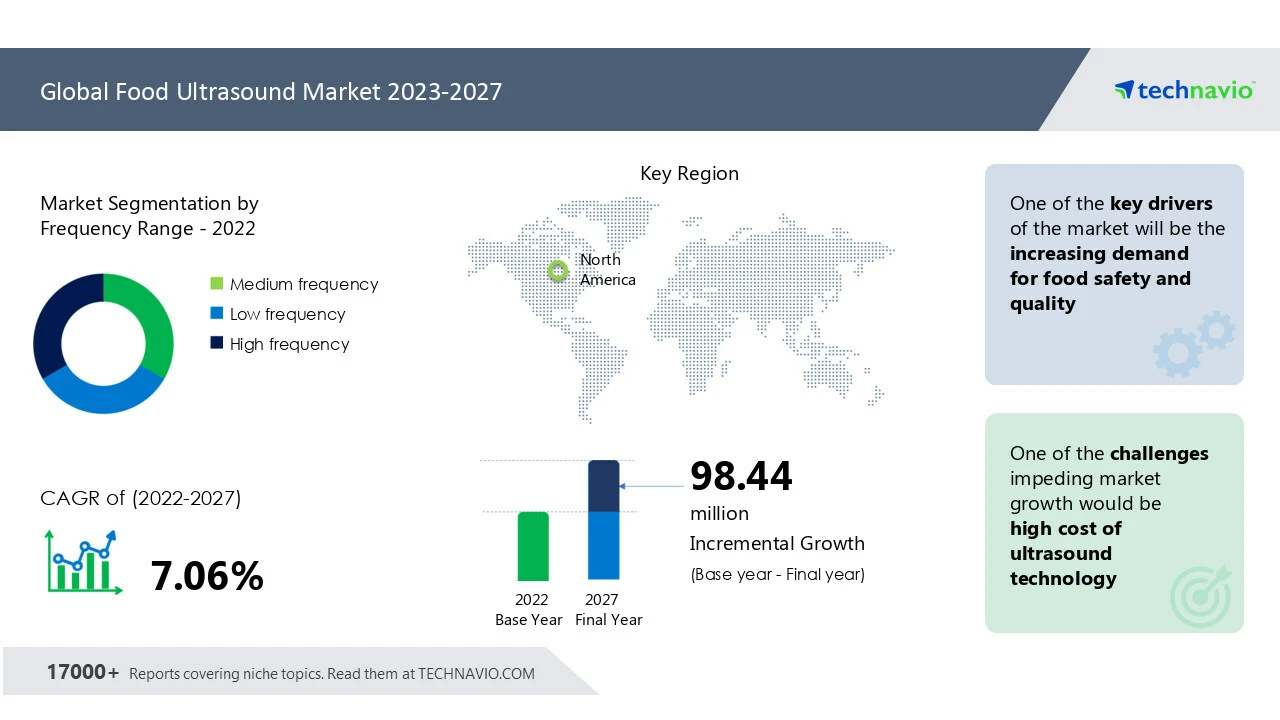
Courtesy PRNewswire, Technavio
NEW YORK — The food ultrasound market is estimated to grow by $98.44 million between 2022 and 2027, according to a new report from market research company Technavio.
The growth momentum will be progressing at a compound annual growth rate (CAGR) of 7.06% during the forecast period, Technavio reports. The market is segmented by frequency range (medium frequency, low frequency and high frequency), application (meat and seafood, fruit and vegetables, beverage, dairy products and others), and geography (North America, Europe, APAC, South America and Middle East and Africa).
The market growth in the medium frequency segment will be significant over the forecast period, according to the report. The segment is mainly driven by the technological benefits of using medium-frequency food ultrasound. It destructs blemishes and makes sure that the food samples are not damaged or altered during the analytical process. This is crucial, as quality is paramount in the food and beverage industry and optimizes cost and time, thereby improving the overall efficiency of the production process.
The market is driven by the rising demand for food safety and quality. Consumers are exhibiting high demand for safe and healthy food products due to growing concerns over food safety, says Technavio. Hence, food manufacturers are striving to improve the quality and safety of food products. They adopt ultrasound technology to detect food contamination at an early stage. This ensures that only safe and quality food reaches customers. The use of this technology helps reduce food-borne diseases caused by contaminated food, which is one of the major global health issues. Thus, the increased demand for food safety and quality will drive the growth of the market during the forecast period.
MAJOR TRENDS. Ultrasound food testing is becoming increasingly popular in the dairy industry, according to the report. The technology is being adopted by dairy companies for the analysis of milk and dairy products. It reduces manual testing, which can be time-consuming and expensive. Ultrasound analysis can detect changes in milk composition, such as fat and protein content, which are crucial in maintaining quality. It can also measure milk homogenization, cheese texture and other parameters that are important in dairy products. Thus, the increasing use of ultrasound technology in the dairy industry will positively impact the growth of the market during the forecast period.
KEY CHALLENGES. Food ultrasound equipment requires significant initial investment by end-users. The high cost of the technology acts as a barrier for small and medium-sized food manufacturers having limited budgets. It also limits the entry of other players, which leads to reduced competition. This, in turn, will result in higher prices for customers. These factors challenge the growth of the market in focus.
Read the full report here.
Latest from Quality Assurance & Food Safety
- Phytolon Secures Investment from Rich Products Ventures to Help Bring Natural Replacement for Synthetic Food Dyes to Market
- Yu Shang Food Inc. Recalls Ready-to-Eat Meat and Poultry Products Due to Possible Listeria Contamination
- Peanut and Tree Nut Processors Association Launches Fifth Edition of ‘The Handbook for the Safe Handling and Processing of Nuts’
- Migratory Birds Raise Bird Flu Concerns
- CEJN Releases Metal and X-ray Detectable Blow Gun
- FDA Releases Supplement to 2022 Food Code
- FDA and EPA Announce First Registered Pre-Harvest Agricultural Water Treatment
- USDA’s Agricultural Research Technology Center Breaks Ground in California





